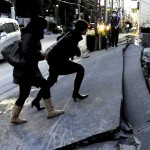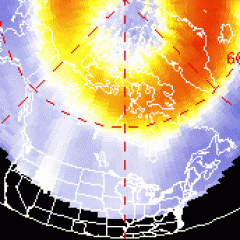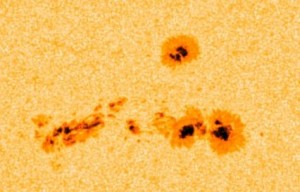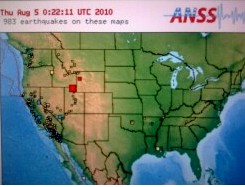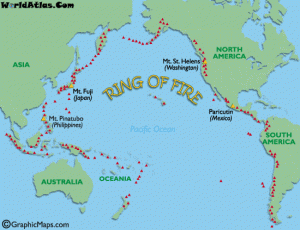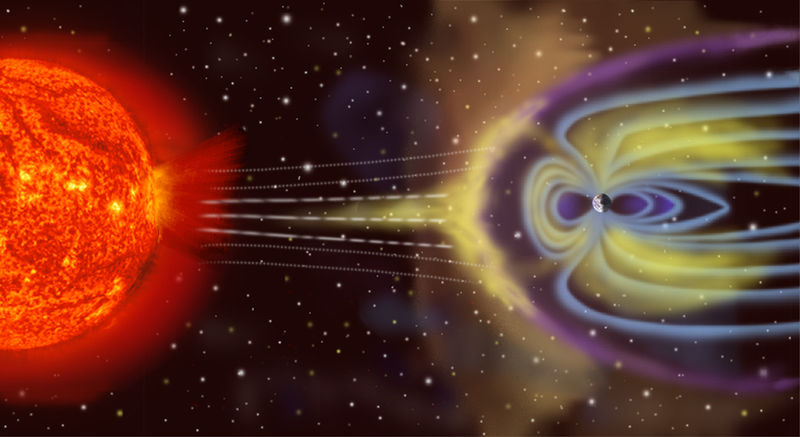
Beautiful graphic of solar wind impacting the planetary geomagnetic field. Source: unknown.
Sunday, April 4th of this year, would’ve been like any other day – except that there was an unusual earthquake under West Virginia early that morning. The next day an explosion rocked the coal mine in the near-quake zone, possibly caused by built-up toxic gasses enriched by the quake. Twenty-nine miners lost their lives.
As far as blame goes, all eyes are on the mining company. Yes, Massey Mining carried some violations, and those violations – specifically those related to gas venting – may have played a role in the mine tragedy. But why no mention in the mainstream media of the earthquake near Gassaway and the Massey mine the day before the explosion? Is the correspondence between seismic and solar activity being deliberately ignored or downplayed, despite spikes in seismic activity around 4 April 2010, the day of the West Virginia temblor and the Baja California quake?
These notable earthquakes were accompanied by an exceptionally strong solar wind which impacted Earth’s magnetosphere just before daylight hours on the 5th in North America, and “sparked the strongest geomagnetic storm of the year,” according to Spaceweather.com’s archives. Might this strong solar wind have precipitated seismic activity by its impact on the planet’s geomagnetic field and kinetic molten magnetic core?
Spaceweather’s auroral oval graphic makes it easy to observe the gyrations of Earth’s fluxing magnetic fields and make connections between Sun and Earth activity. The northern auroral oval was both inflamed and lopsided around the time of the West Virginia and the Mexicali quakes. The bright orange stretching equatorward indicates that our planet’s magnetosphere is being pommelled with solar wind. I suspect Earth’s iron core is spinning more freely due to its recent relative slumber, and reacting more vigourously to the Sun’s magnetic influences than a decade or two ago.
In other words, the planet’s poles have limbered up to the point that humans – among Earth’s most notorious freeloaders – may be thrown from the surface by a sudden worldwide jolt that one-ups recent seismic outbursts. Readily available numbers give a general feel for what’s going on. While I’m unsure of the implications of all the information I gather, I’m finding that increased solar wind combined with lower particle density seems to create marked instability in Earth’s crust and correspondingly-increased seismicity.
Now for some technical information, which needs to be understood in a certain context, which I’ll explain briefly: The US Geological Survey posts magnitude 1+ USA quakes for the past week here, and world quakes of 4.5+ (including US quakes 2.5+) on a separate map here.
A few weeks ago, on the morning of 25 March, 2010, there were 850 quakes on the US map, and 212 on the world map. At the same time, I noticed Yellowstone was acting up again with a minor swarm. By the 5th – the day after the West Virginia quake associated with the underground explosion at Massey Mine near Gassaway – the US registered a pretty strong 1313, and the world number jumped to 638.
During the last week, with Earth in the path of a strong solar windstream, the number of earthquakes grew remarkably: 2965 in the US and 1269 on the world map, as of 9 PM on Thursday, the 8th of April, 2010. Friday the 9th I saw there are 3091 earthquakes on the USA map and 1307 on the world map. While some of these represent aftershocks from the Mexicali 7.2, that’s still a pretty rapid jump. Numbers continued to grow daily until the past 24 hours or so.
Observing a trend between the intensity and irregularity of the auroral oval, combined with solar activity and Earth’s seismic activity, may lead to better predictive capacities toward what seem to be Earth-based phenomena, but is really the result of a blending solar and planetary energies. Of what value, however, is the prediction if most people can’t comprehend it, let alone feel compelled to take action? Even if forewarned of the possibility of massive, imminent Earth changes linked with flaring outbursts of 2012-era Sun rhythms, would most people have the capacity to process that information? Might panic ensue?
A CME impacted Earth a couple of days ago, and the Sun is growing quiet once again. This evening, Tuesday 13 April 2010, earthquake numbers are gradually receding like the tide from the shore.
As Spaceweather frequently advises, “Monitoring is encouraged.”
STACE TUSSEL
NOTE:
Here’s a link to an abstract investigating a possible connection between earthquakes and explosive gas emissions into coal mines.
